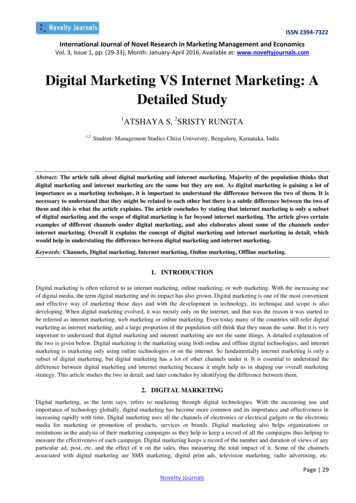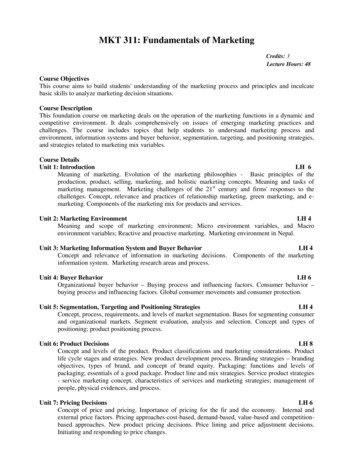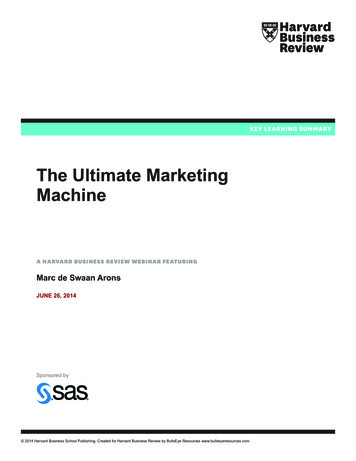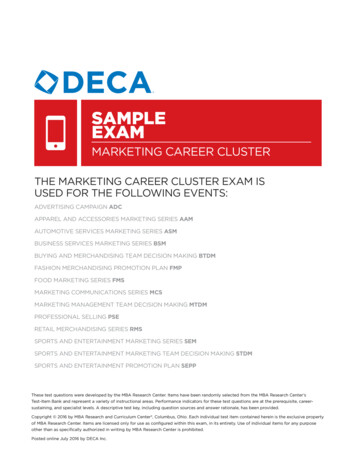
Transcription
SOCIAL PURPOSE INSIGHT PAPER JANUARY 2021Purpose Marketing:The Rise of thePurpose-Led BrandSOCIALPURPOSE.CA
INTRODUCTIONIn a purpose-driven business, the role of marketing changes: From advertising your products or servicesto building a social purpose brand ecosystem. From communicating to your customers to engaging themon purpose-inspired actions. From paid media to earned media. From passive to active customers – tocustomers who co-create new purpose products and amplify your message.More and more consumers identify as belief-driven buyers, nearly two thirds according to Edelman’s 2020Trust Barometer. That means they choose/switch/avoid/boycott a brand based on its stand on societalissues. Buying on belief is the new normal. Yet – attracting and retaining these consumers has been amystery. Until now.The Social Purpose Institute held a dialogue with three social purpose marketing visionaries in November2020 to explore these questions and more. Here is a link to the webinar discussion.Read on to learn how the role of marketing changes in a purpose-led company. By following theseinsights marketers can build the company brand, attract and engage customers, and accelerate progresstoward the company’s social purpose.REPORT STRUCTURE The Changing Role of Marketing How Marketing is Different in a Social Purpose Company Purpose Marketing Stages Engaging Customers on Your Purpose Dealing with Risks and PitfallsTHE DEFINITION OF A SOCIAL PURPOSE BUSINESSA Social Purpose Business is a company whose enduring reason for being is to create a better world.It is an engine for good, creating societal benefits by the very act of conducting business. Its growthis a positive force in society. For more info, download the Social Purpose Business Case.pdf.SO C I A L P U RP OSE IN SIG H T PAPER PURPO S E MARK ET ING: T HE RISE O F THE P U R P O SE - L E D B R A ND2
REPORT HIGHLIGHTS Driven by technological and societal trends, marketing is undergoing a rapidtransformation One of the trends affecting marketing is that companies are adopting a social purposeas the reason their company exists – this changes the way marketing is practiced incompanies Marketers become storytellers, and focus on mobilizing customers, employees,and stakeholders on the purpose – and telling their stories Building your purpose into everything you do communicates your purpose to yourcustomers by the very act of conducting your business Customers want to know the people and values behind the brand, and this isbecoming part of the value proposition Stakeholders can help you achieve your purpose and build your brand – and they willhold you accountable for it Leaning into your purpose will attract customers – and those that hold back can becultivated as purpose ambassadors in the future Once your purpose is in everything you do, it becomes an indelible part of thecustomer experienceABOUT THE SOCIAL PURPOSE INSTITUTEThe Social Purpose Institute (SPI) at United Way exists to grow business for good, partneringwith companies and collaborating with governments, allied organizations, and others to growthe Social Purpose Business movement. We achieve this in several ways. We help businessesdefine and implement their social purpose to drive both business growth and societal good.We champion a purpose-led economy, accelerating the new business ethic to create longterm well-being for all. We are thought leaders, creating and curating insights and knowledgeto define the transition pathway to the purpose-led economy. We convene the social purposeecosystem – the partners and actors needed to bring social purpose to life in communitiesacross Canada. Together, we build a better world through business.For more information, visit us at www.socialpurpose.ca.SO C I A L P U RP OSE IN SIG H T PAPER PURPO S E MARK ET ING: T HE RISE O F THE P U R P O SE - L E D B R A ND3
PURPOSE MARKETING: THE RISE OFTHE PURPOSE-LED BRANDTHE CHANGING ROLE OF MARKETINGBefore we can understand the context in which Purpose Marketing is taking centre stage, weneed to understand how marketing has changed over the past decade. These are the trends weare seeing: IN-HOUSE MARKETING: The advertising industry has been turned on its head.The traditional agency model is evolving with companies taking marketing in-houseand seeking specialist firms for key skills and insights. CONSUMER CONNECTIONS: Consumers are seeking stronger connections to brands.Authentic brands that show they care about the human condition are being rewarded. COLLECTIVE CITIZENS: Citizens are more in tune with societal issues than ever before.Driven by COVID-19, their interests have changed from the personal to the collective. PRODUCT ATTRIBUTES: Customers used to care more about product and price. Thenit became a focus on customer service, speed, and convenience. While these previousattributes are still important, now customers are focused on purpose and are voting formeaningful brands with their dollars. PEOPLE-CENTRED: Buyers are looking at the brand offering the product or serviceand are going deeper, they are looking at the people behind the brand, behindthe product and service. Given the influence of social media, including Facebook,Instagram and LinkedIn, buyers know more about the person they are talking to at theother end of the line than ever before. SHORT ATTENTION: Consumers have shorter attention spans. Now they have somany sources of information, so many places they can go to find similar products andservices. As Simon Sinek has said: “people are not necessarily buying what you do,but why you do it.” Purpose provides that why and purpose marketing provides theheart and the connection to the consumer – and enables companies to differentiatethemselves within the clutter.“ Ultimately purpose provides the why and purposemarketing helps communicate that why from the heart.”– Anne Donohoe, Marketing AdvisorSO C I A L P U RP OSE IN SIG H T PAPER PURPO S E MARK ET ING: T HE RISE O F THE P U R P O SE - L E D B R A ND4
HOW MARKETING IS DIFFERENT IN A SOCIAL PURPOSE COMPANYAs marketing trends evolve, as customers seek stronger connections to brands, and as companiesbegin to adopt or upgrade a social purpose as the reason their company exists, marketing pivotsand taps into new levers within and beyond the company. These are just some of the changesmarketers can expect: STORYTELLING: Marketers become storytellers rather than advertisers. EMPLOYEE ROLE: If everything your employees do tells your story, by executing onyour purpose you tell your story; it’s a new way of looking at your marketing resourcesbecause the employee base becomes engaged in the story and message. CUSTOMER ROLE: Marketers tell the stories of others amplifying their social purpose,including the stories of their customers and partners who want to demonstrate theirown purpose credentials. COMMUNITY AMPLIFICATION: Less money is spent on advertising due to communityamplification of your message; you gain earned media and word of mouth from yourpurpose activation. RECIPROCITY: Social purpose companies shift their communications from monologueto dialogue and from benevolence to reciprocity; they develop reciprocal relationshipswith stakeholders. B2P: Social purpose companies go beyond B2B and B2C distinctions, as “peoplebuy and companies pay” at the end of the day. All businesses sell to people.Purpose-driven businesses assume people are buying with their whole selves andaddress the whole person in their communications. AUTHENTICITY: Marketing becomes easier because you are no longer trying tocraft a veil of authenticity.“ We go by the saying: ‘people buy and companies pay’.We’re all B2P – we’re all businesses selling to people. We need toassume people are buying with their hearts and lead with that.”– Chris Peacock, Chief Marketing Officer, Traction on DemandSO C I A L P U RP OSE IN SIG H T PAPER PURPO S E MARK ET ING: T HE RISE O F THE P U R P O SE - L E D B R A ND5
PURPOSE MARKETING STAGESPurpose marketers take a phased approach to the work. Before publicly communicating the purpose,they first engage their employees and collect proof-points on the purpose. After employee engagement,marketers mobilize their stakeholders and finally their customers.1) Start with your employeesEnsure your employees understand the social purpose and how it applies to their work, the “what’s init for me” kind of issue. Employees need to understand what your social purpose is and how it relatesto their areas of responsibility. You will need to spend more time than you think necessary, to buildthe internal understanding and alignment. This is very important. You need to start with your coreemployee base and work your way out, much as you do with efforts to evolve your brand or rebrand yourorganization. Success comes through customer touchpoints with all staff – it creates a brand feel anddrives brand equity.“ At the heart of it all is the staff: the passion for the purposecomes through in their communications and customers feelthat and can’t help but get excited as well.”– Anne Donohoe, Marketing Advisor2) Cascade your purpose to your stakeholdersFrom this strong internal base, you can cascade your purpose out to your key stakeholders. Leading socialpurpose companies excel at stakeholder engagement. To fulfill your purpose, you need to collaboratewith stakeholders who share your goals. Your approach to partnerships will likely change as you buildan ecosystem around your company based on shared value and shared purpose. It can’t be a one-waystreet – you also need to support other organizations in your stakeholder ecosystem on their socialpurpose. This results in deeper stakeholder and customer relationships. As you build out your ecosystemyour partners become part of telling your story. As you engage your stakeholders on your purpose, theybecome ambassadors for your purpose and amplifiers of your brand. Marketing now has ALL stakeholdersto think about and brings this perspective into the company.“ Social purpose companies shift their communications frommonologue to dialogue and from benevolence to reciprocity.”– Peter ter Weeme, Chief Social Purpose Officer and VP Player Experience, BCLCSO C I A L P U RP OSE IN SIG H T PAPER PURPO S E MARK ET ING: T HE RISE O F THE P U R P O SE - L E D B R A ND6
3) Invite your customers to join your movementAfter you have engaged your employees and mobilized your stakeholders on your purpose, it is time todevelop your external marketing activities. This is when you invite your customers to join the movementyou are creating around your brand. Marketing takes on a more holistic stance, as now everything you doand say as a company is marketing your social purpose. However, don’t forget it is not possible to “winthe deal” on purpose alone. You also need quality, service, and product. You must weave your purposeinto your offer and your offer into your purpose.“ Social purpose companies should have anopinion, share it, and be willing to take the riskof sharing that opinion.”– Chris Peacock, Chief Marketing Officer, Traction on DemandHOW DO YOU ACTIVATE AND ENGAGE YOURCUSTOMERS ON YOUR PURPOSE?Purpose-led companies seek to engage their customers on their purpose.They envision an engaged customer base, who gain meaning from theirinvolvement, and who also help the company advance its social purposeobjectives. Here are some tactics for mobilizing your customers based onshared aspirations.Look for opportunities to engage your customers. First, consider thetopics and issues employees care about as revealed in their conversationscirculating internally. Build on those, and then bring in your stakeholderpartners. That creates the magic. As it builds you can start engaging yourcustomers in the conversation.TAKING A STAND ONISSUESWhen you take a stand on issuesyou can have more meaningfulconversations and amplify them.Social purpose companies shouldhave an opinion, share it, and bewilling to take the risk of sharingthat opinion. You may send a certaintype of buyer away from your brand;however, you will bring a certain typeof buyer even closer.If your customer is not receptive toyour purpose, you can fall back onyour product and your service andyour conventional differentiator.The impact of this dialogue is about more than impressions – it is abouthaving people feel they have been seen and heard and are participating inpowerful conversations. This is an opportunity to bring more people into your community thatwould never have considered you before. Of course, you need to be strategic when deciding whento amplify and go deep on an issue.One way of activating your customer base is to create a community around your brand, that yourcustomers can join and participate in and where their voice can be heard.Give people tools to help them tell your story. With social media, you can provide memes, badges, andother forms of recognition to share with their networks. Tell the stories of your customers using your socialpurpose products and engaging in your social purpose efforts – they will be inspired to share those storieswith their networks. Recognize that word of mouth doesn’t happen organically –an overnight success story takes years to create!SO C I A L P U RP OSE IN SIG H T PAPER PURPO S E MARK ET ING: T HE RISE O F THE P U R P O SE - L E D B R A ND7
DEALING WITH RISKS AND PITFALLSPurpose marketers need to be aware of the risks and pitfalls of marketing a purpose-driven brand. Hereare three to pay attention to.How do you avoid purpose-washing?Purpose-washing, like greenwashing, means presenting your company as something it is not. Thesedays there are a number of watchdogs, whose voices are accelerated by social media. Social media hasdemocratized the ability of citizens and watchdog groups to call out inauthenticity when they see it. It isimportant for your purpose to be aspirational because that is what social purpose is about: a north staryou are pursuing. However, as you are on the path of this purpose, you need to be humble about thejourney you are on. You need to ensure your employees understand and believe in your purpose and youshould be deeply engaged with your stakeholders in collaborations on your purpose.In the past, brands felt they owned the brand and were very protective of it. These days, you don’town your brand anymore. It is owned by your customers and stakeholders. Companies need to getcomfortable about giving this ownership away. Those that do will avoid purpose-washing. They willrecognize it is not possible to control every message, every action and every implication associated withtheir social purpose.By conducting good stakeholder engagement, and by collaborating with stakeholders on your socialpurpose, they will both help you build your brand and also hold you accountable for it. Through theseenmeshed partnerships, you will hear early and first-hand their reactions, so you can pivot quickly if needbe. This can fortify you against purpose-washing if done properly.“ You don’t own your brand anymore. Your customers andstakeholders own the brand.”– Peter ter Weeme, Chief Social Purpose Officer and VP Player Experience, BCLCWhat do you do if customers are not receptive to your purpose?It is important to lead with your purpose. If customers are not receptive to it, it is rarely a downfall andthen you move on to your other differentiators. At the same time, you can’t be friends with everyone.You must pick a lane and go down it. You should be willing to say no and to alienate some groups that donot have aligned values. Your values should be aligned to your addressable market. Over time you couldmigrate the customer that comes in looking only for price and quality to become an ally on your purpose.Customers know what the prices are elsewhere, this becomes almost standardized. You need to beable to put your purpose and your values out on the table and say “This is exactly who we are. This is acollection of people behind our products and our services. Does this resonate with you? And do we wantto be partners in this?”This is even the case for transactional items: your customers become your partner and ambassador. Theywear your products, use your brands, or work with you from a service standpoint. Basically, you and yourcustomers are qualifying each other. You need to qualify them as much as they need to qualify you.SO C I A L P U RP OSE IN SIG H T PAPER PURPO S E MARK ET ING: T HE RISE O F THE P U R P O SE - L E D B R A ND8
Are there times when purpose can or should be left out of the conversation?Once your social purpose is truly embedded, it flows through everything you do. In this way, it is neverleft out of the conversation. It becomes inherent and built into the authentic language of the productor service. You may want to have special programs that amplify your purpose occasionally, but once it isembedded it is communicated in all the customer touch points.You still need to understand your customer’s journey, how they make decisions and at what point theyneed certain types of information. This could be to inspire and motivate them and have them feel goodabout their purchase, or to provide technical and functional attributes of the product and price to helpthem make a decision. It comes back to understanding your customer and what they absolutely needat certain times of the decision-making process – and the amazing opportunities to bring in the socialpurpose message and to activate them and bring them along.“ We need to qualify our customers just as they need to qualifyus as vendors or suppliers.”– Chris Peacock, Chief Marketing Officer, Traction on DemandCONCLUSIONIncreasingly companies are expected to adopt a social purpose as the reason they exist to contribute toa thriving future for all. For those that do, this changes the way marketing is practiced in the company.Marketers become a strategic player to help execute on the purpose, by mobilizing employees,stakeholders and customers to help accelerate the social purpose and foster meaningful relationships withthose critical to its success.Social purpose companies create a movement around their brand, engage their customers in helpingachieve the social purpose, and build a purpose ecosystem to accelerate their messaging and impact.Welcome to the new age of marketing.SOCIA L P U RP OSE INS IGHT PAPER CO NT RIBUT O RSCoro Strandberg, Social Purpose Advisor to, and co-founder of, the Social Purpose Institutemoderated the panel and prepared this summary.Panelists included: Anne Donohoe, Marketing Advisor and global marketing executiveChris Peacock, Chief Marketing Officer at Traction on DemandPeter ter Weeme, Chief Social Purpose Officer and VP, Player Experience at BCLCContact Mary Ellen Schaafsma, Director, Social Purpose Institute, if you would like to learnmore about defining, articulating and implementing a social purpose in your company.SOCIALPURPOSE.CAE M A ILengage@socialpurpose.caTE L604.294.8929 x2252Follow us @SocialPurposeIn
B2P: Social purpose companies go beyond B2B and B2C distinctions, as “people buy and companies pay” at the end of the day. All businesses sell to people. Purpose-driven businesses assume people are buying with their whole sel











